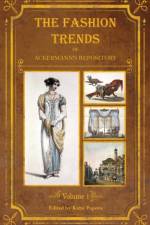- With Additional Pictorial Reference to All Other Plates Issued 1809-1813
447
Rudolf Ackermann was already a successful carriage-maker, paper maker, and high quality printer by the time he started the Repository of Arts, Literature, Commerce, Manufactures, Fashions, and Politics in January 1809. This renowned British periodical ended publication in 1828 and was simply known as Ackermann's Repository during its run. The last issue of the Repository appeared in December 1828. Ackermann's Repository covered a wide range of topics targeted to both gentlemen and ladies. The variety of the articles is reflected in the colour plates published throughout the years. From hunting and fishing, landscapes, famous places and houses, new inventions to plans for cottages and gazebos, it covered it all. In its day, it had great influence on English taste in fashion, architecture, and literature. To this day the periodical is highly sought by collectors, with the fashion plates being one of the most prized. The quality and vibrancy of the prints are unsurpassed among the other Regency publications. Over the years many catalogues both in print and online have been created in order to help collectors assess the completeness of the Ackermann volumes they purchase. Like many other admirers I started with acquiring some individual engravings. Even though all plates are identified by plate number and volume in general, when trimmed for binding this helpful informationis often lost. Searching the Net in order to connect a date and other necessary information to a print I have just purchased, proved very frustrating. When purchasing a complete bound volume - quick, at a glance reference as to what plates should be included in each volume proved even harder to come by. For me, being a visual person, the ability to see, without wasting a lot of time in various searches, was more important than anything. I needed a resource, independent of a screen, which I can take to auctions, dusty attics and antique shops. This reference book aims to give you exactly that. It will not reveal groundbreaking or unknown facts about the publishers or the volumes, but simply give you a complete quick access to every plate published in the Ackermann's Repository,printed both in colour or black and white. Since the fashion plates are the most popular, and the only theme consistent throughout the entire run of the periodical I have given them more prominent placement. There are four volumes in this reference series each covering 10 of the original Ackermann's Repository volumes. Each plate is identified by its year, volume and number as well as a title. A note is left in the few occasions where a number is missing, or a plate appears in a different part of the year as opposed to what was originally intended. I hope that you will enjoy perusing the pages and find as much pleasure seeing the fashion, furniture and art tastes change through the years as I had researching the Repository. I hope that you will be inspired to preserve the books in their entirety and enjoy the articles as much as the art work.




